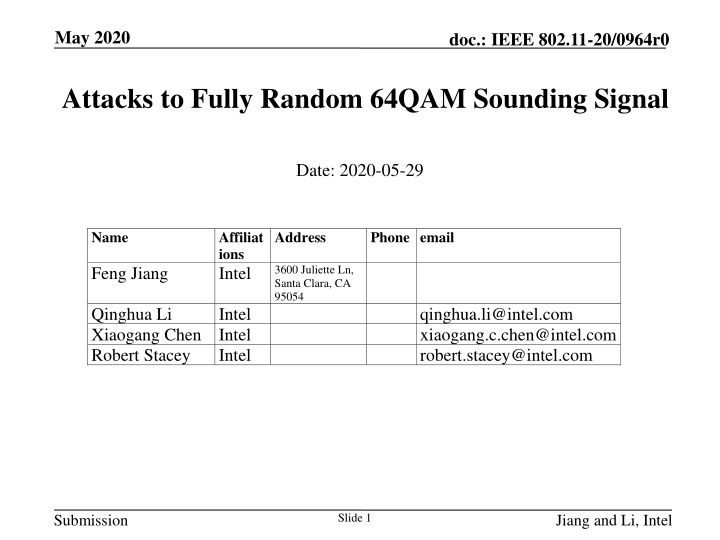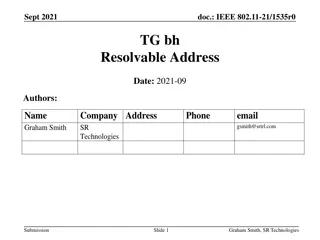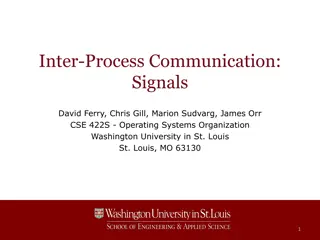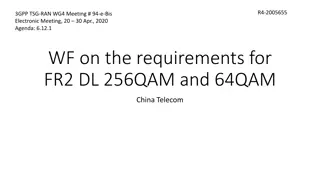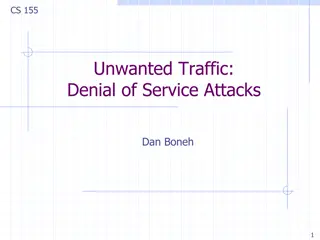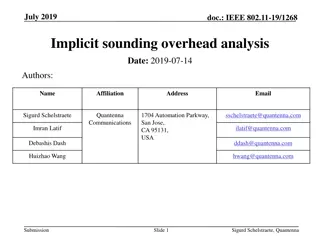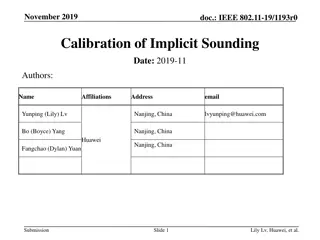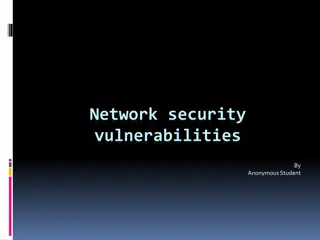Attacks on Fully Random 64QAM Sounding Signal in IEEE 802.11-20/0964r0
Presentation by Intel demonstrates vulnerabilities in fully random QPSK and 64QAM sounding signals in IEEE 802.11-20/0964r0. Proposed attack methods, including Viterbi equalizer attacks, and solutions such as Secure LTF mechanism and windowed FFT are discussed to enhance security in ranging. The presentation also covers observations on attacker behavior and techniques like decoding and sphere decoding to counter attacks effectively.
Download Presentation

Please find below an Image/Link to download the presentation.
The content on the website is provided AS IS for your information and personal use only. It may not be sold, licensed, or shared on other websites without obtaining consent from the author.If you encounter any issues during the download, it is possible that the publisher has removed the file from their server.
You are allowed to download the files provided on this website for personal or commercial use, subject to the condition that they are used lawfully. All files are the property of their respective owners.
The content on the website is provided AS IS for your information and personal use only. It may not be sold, licensed, or shared on other websites without obtaining consent from the author.
E N D
Presentation Transcript
May 2020 doc.: IEEE 802.11-20/0964r0 Attacks to Fully Random 64QAM Sounding Signal Date: 2020-05-29 Name Affiliat ions Intel Address Phone email 3600 Juliette Ln, Santa Clara, CA 95054 Feng Jiang Qinghua Li Xiaogang Chen Intel Robert Stacey Intel qinghua.li@intel.com xiaogang.c.chen@intel.com robert.stacey@intel.com Intel Slide 1 Submission Jiang and Li, Intel
May 2020 doc.: IEEE 802.11-20/0964r0 11az LB249 CID 3911 CID Page/Line Clause Comment Proposed resolution 3911 153.00 11.22.6.4.6 The Secure LTF mechanism for TB and NTB ranging needs to be improved. A submission will be provided. As in comment. Submission Slide 2 Jiang and Li, Intel
. May 2020 doc.: IEEE 802.11-20/0964r0 Background In a previous presentation we demonstrated that the fully random QPSK LTF is vulnerable to Viterbi equalizer attacker [1]. The contribution [6] proposed fully random 64QAM LTF for secured ranging. The main reason is the prohibitive attack complexity. In this submission, we present an attack method with a implementable complexity, decoding (SD) and successive interference cancellation (SIC) to efficiently decode the fully random 64QAM LTF. which employs sphere Submission Slide 3 Jiang and Li, Intel
March 2020 doc.: IEEE 802.11-20/0964r0 Observation Window Attacker observes the beginning portion and detects the phases of the sinusoids for generating shifted attack signals Attack window Observation window Submission Slide 4 Jiang and Li, Intel
May 2020 doc.: IEEE 802.11-20/0964r0 Windowed FFT (1/2) Time-domain window is applied to weight the input signal and then FFT is performed on the weighted signal Submission Slide 5 Jiang and Li, Intel
May 2020 doc.: IEEE 802.11-20/0964r0 Windowed FFT (2/2) The longer the window in time, the fewer the significant taps in frequency Submission Slide 6 Jiang and Li, Intel
May 2020 doc.: IEEE 802.11-20/0964r0 Windowing in Time, ICI in Frequency The time-domain windowing introduces inter-carrier interferences in frequency domain Submission Slide 7 Jiang and Li, Intel
May 2020 doc.: IEEE 802.11-20/0964r0 Signal Model ISI channel in frequency domain Conventional equalization methods such as Viterbi equalizer can be applied Decision-feedback equalizer will be evaluated in this work Freq Submission Slide 8 Jiang and Li, Intel
May 2020 doc.: IEEE 802.11-20/0964r0 Principle Sequential Vector Detection and SIC Starting from band edge, detect QAM symbols jointly within a sliding window Remove the detected signal and move the sliding window toward the band center recursively Freq MIMO channel with 4 streams Freq Sliding window Submission Slide 9 Jiang and Li, Intel
May 2020 doc.: IEEE 802.11-20/0964r0 Sphere Decoding Sphere decoding is a well-developed algorithm for vector detection Popularly implemented in cellular and WiFi devices for MIMO receiver Sphere decoding solves the following integer least-square problem with polynomial complexity [2, 3] ??? ? ?? ? ?2 where the signal models are defined below: ? = ?? + ? Observed signal ?, unknown vector ?, observation noise ? generation matrix ? Submission Slide 10 Jiang and Li, Intel
May 2020 doc.: IEEE 802.11-20/0964r0 Sphere Decoding (Cont d) min ? ?? ? ?2 ?1,4 ?2,4 ?3,4 ?4,4 ?4 2 ?1,3 ?2,3 ?3,3 ?1,2 ?2,2 ?1 ?2 ?3 ?1 ?2 ?3 ?4 ?1,1 2+ ?3 2+ ?2 2+ ?1 2 = ?4 ?2 Calculate the distance from the received signal point to each constellation point within a chosen radius Declare the constellation point with the shortest distance as the solution r ?4= 11 10 01 00 y Submission Slide 11 Jiang and Li, Intel
May 2020 doc.: IEEE 802.11-20/0964r0 Recursive Detection and Cancellation Attacker observes part of the time domain random LTF symbols and transform to frequency domain. The frequency domain signal is the circular convolution of the frequency domain window function and the constellation symbol on each tone. Assume attacker decodes the constellation symbol from edge tone, an equivalent MIMO channel can be built. Attacker can sequentially apply sphere decoding and successive interference cancellation (SIC) in frequency domain to decode the symbols on each tone. Submission Slide 12 Jiang and Li, Intel
May 2020 doc.: IEEE 802.11-20/0964r0 An Attacker Example 20MHz bandwidth, 64 QAM random LTF 30 dB SNR and 2x oversampling Observe symbol and weight time domain samples by Hamming window Transforms the windowed signal into frequency domain ?? Submission Slide 13 Jiang and Li, Intel
May 2020 doc.: IEEE 802.11-20/0964r0 Sphere Decoding with Sliding Window Assume the attacker utilizes 4x4 sphere decoder, the equivalent MIMO channel can be built on the spectrum of the Hamming window as H=[Hm(255) 0 0 0 Hm(256) Hm(255) 0 0 Hm(1) Hm(256) Hm(255) 0 Hm(2) Hm(1) Hm(256) Hm(255)] The corresponding observation signal is y=[yF(194) yF(195) yF(196) yF(197)]T The unknown vector is x=[LTF(68) LTF(69) LTF(70) LTF(71)]T Submission Slide 14 Jiang and Li, Intel
May 2020 doc.: IEEE 802.11-20/0964r0 Successive Interference Cancellation and Decoding After attacker decoding the symbol LTF(68),the corresponding interference to the adjacent tones are cancelled and a second 4x4 sphere decoder is built The observation signal is y=[yF,IC(195) yF,IC(196) yF,IC(197) yF,IC(198)]T with yF,IC(195)=yF(195)-Hm(256)*LTF(68) yF,IC(196)=yF(196)-Hm(1)*LTF(68) yF,IC(197)=yF(197)-Hm(2)*LTF(68) yF,IC(198)=yF(198)-Hm(3)*LTF(68) The unknown vector is x=[LTF(69) LTF(70) LTF(71) LTF(72)]T After solving the second sphere decoding, the symbol LTF(69) will be decoded This sequential interference cancellation and decoding procedure can be iteratively applied until all the symbols are decoded. Submission Slide 15 Jiang and Li, Intel
May 2020 doc.: IEEE 802.11-20/0964r0 Complexity Analysis It is a tree search algorithm, which can be parallelized As shown in the paper [4], the number of FLOPS required for solving a single 4x4 sphere decoder with 64QAM modulation could be as low as (103) For the 20MHz bandwidth, the LTF sequence includes 122 data symbols, and the complexity of sequentially solving the 4x4 sphere decoder by 122 times is (105), which is 100 times less than the (107) in [7] In a recent paper [5], with the assistance of a 3-layer deep learning network the complexity of sphere decoder can be significantly reduced compared with the legacy Submission Slide 16 Jiang and Li, Intel
May 2020 doc.: IEEE 802.11-20/0964r0 Simulation Settings 20 MHz bandwidth, 2x LTF Single antenna Tx and Rx AWGN channel between attacker and sounding transmitter with 30 or 45 dB SNR 3/4 or 11/16 LTF symbol is observed by attacker Attacker oversamples time domain LTF by 2 and applies the window Hamming, Han and Blackman windows are evaluated The CDF of the cross correlation between the full length LTF and decoded LTF is plotted For comparison purpose, the CDF of the cross correlation between the LTF in the attack window and the decoded signal in the attack window is also plotted Submission Jiang and Li, Intel Slide 17
May 2020 doc.: IEEE 802.11-20/0964r0 Simulation Results (1) 3/4 LTF observation and Hamming window 50% success rate Submission Slide 18 Jiang and Li, Intel
May 2020 doc.: IEEE 802.11-20/0964r0 Simulation Results (2) 3/4 LTF observation and Hamming window 25% success rate Submission Slide 19 Jiang and Li, Intel
May 2020 doc.: IEEE 802.11-20/0964r0 Simulation Results (3) 11/16 LTF observation and Han window 25% success rate Submission Slide 20 Jiang and Li, Intel
May 2020 doc.: IEEE 802.11-20/0964r0 Simulation Results (4) 11/16 LTF observation and Han window 20% success rate Submission Slide 21 Jiang and Li, Intel
May 2020 doc.: IEEE 802.11-20/0964r0 Simulation Results (5) 3/4 LTF observation and Hamming window Submission Slide 22 Jiang and Li, Intel
May 2020 doc.: IEEE 802.11-20/0964r0 Simulation Results (6) 3/4 LTF observation and Hamming window Submission Slide 23 Jiang and Li, Intel
May 2020 doc.: IEEE 802.11-20/0964r0 Simulation Results (7) 3/4 LTF observation and Blackman window 34% success rate Submission Slide 24 Jiang and Li, Intel
May 2020 doc.: IEEE 802.11-20/0964r0 Simulation Results (8) 3/4 LTF observation and Blackman window 31% success rate Submission Slide 25 Jiang and Li, Intel
May 2020 doc.: IEEE 802.11-20/0964r0 Conclusions Our results showed that fully random 64 QAM signal is not secure enough against attacks. Using a larger size sphere decoder e.g. 6x6 or 8x8, the attacker can improve the attack performance e.g. smaller observation windows and lower SNR. Window functions other than the evaluated ones may also improve attack performance. Submission Slide 26 Jiang and Li, Intel
May 2020 doc.: IEEE 802.11-20/0964r0 On Attack Window Size Discussions in [6] assume a constraint that the fake path is within a certain dB e.g. 10 dB down from the main true path This is impractical The true paths may not even be received by the intended receiver The attacker can pick up the weak sounding signal with directional antennas and then send the attack signal to the intended receiver Submission Slide 27 Jiang and Li, Intel
May 2020 doc.: IEEE 802.11-20/0964r0 Example of Self-Interference SNR -6 dB, BW 160 MHz, attack window 1/5 AWGN-like sounding signal Matched filter is used as channel estimator Similar SINR level Submission Slide 28 Jiang and Li, Intel
May 2020 doc.: IEEE 802.11-20/0964r0 Remarks The detection of the SINR degradation due to small attack window may not be reliable It is hard to standardize the attack detection, which usually depends on the receiver implementation The overall ranging security relies on both of the ranging parties instead one, where one party doesn t have the full control of the other It is desirable to have a secure ranging scheme that minimizes the requirement of attack detection Submission Slide 29 Jiang and Li, Intel
May 2020 doc.: IEEE 802.11-20/0964r0 Reference [1] Q. Li, F. Jiang, X. Chen, and R. Stacey, Attacks to Fully Random QPSK Sounding Signal, doc: IEEE 802.11-20-0710r1. [2] U. Fincke and M. Pohst. Improved methods for calculating vectors of short length in a lattice, including a complexity analysis. Mathematics of Computation, 44 (170):463 471, April 1985. [3] T. Kailath, H. Vikalo, and B. Hassibi, MIMO receive algorithms , Space- Time Wireless Systems: From Array Processing to MIMO Communications, pp. 302-321. Cambridge: Cambridge University Press, 2006. [4] A. M. Chan and I. Lee, A New Reduced-Complexity Sphere Decoder For Multiple Antenna Systems , pp. 460-464, IEEE International Conference on Communications, May 2002. [5] M. Mohammadkarimi, M. Mehrabi, M. Ardakani, and Y. Jing, Deep Learning-Based Sphere Decoding , pp. 4368-4378, IEEE Transactions on Wireless Communications, vol. 18, no. 9, Sept. 2019. [6] B. Tian, et al., 11az Secure LTE Design, doc: IEEE 802.11-20-0836r0. [7] J. Dogan, et al., Computational Attacks on 11az PHY Secure Ranging, doc: IEEE 802.11-19-0374r0. Slide 30 Submission Jiang and Li, Intel
May 2020 doc.: IEEE 802.11-20/0964r0 Backup Slide 31 Submission Jiang and Li, Intel
